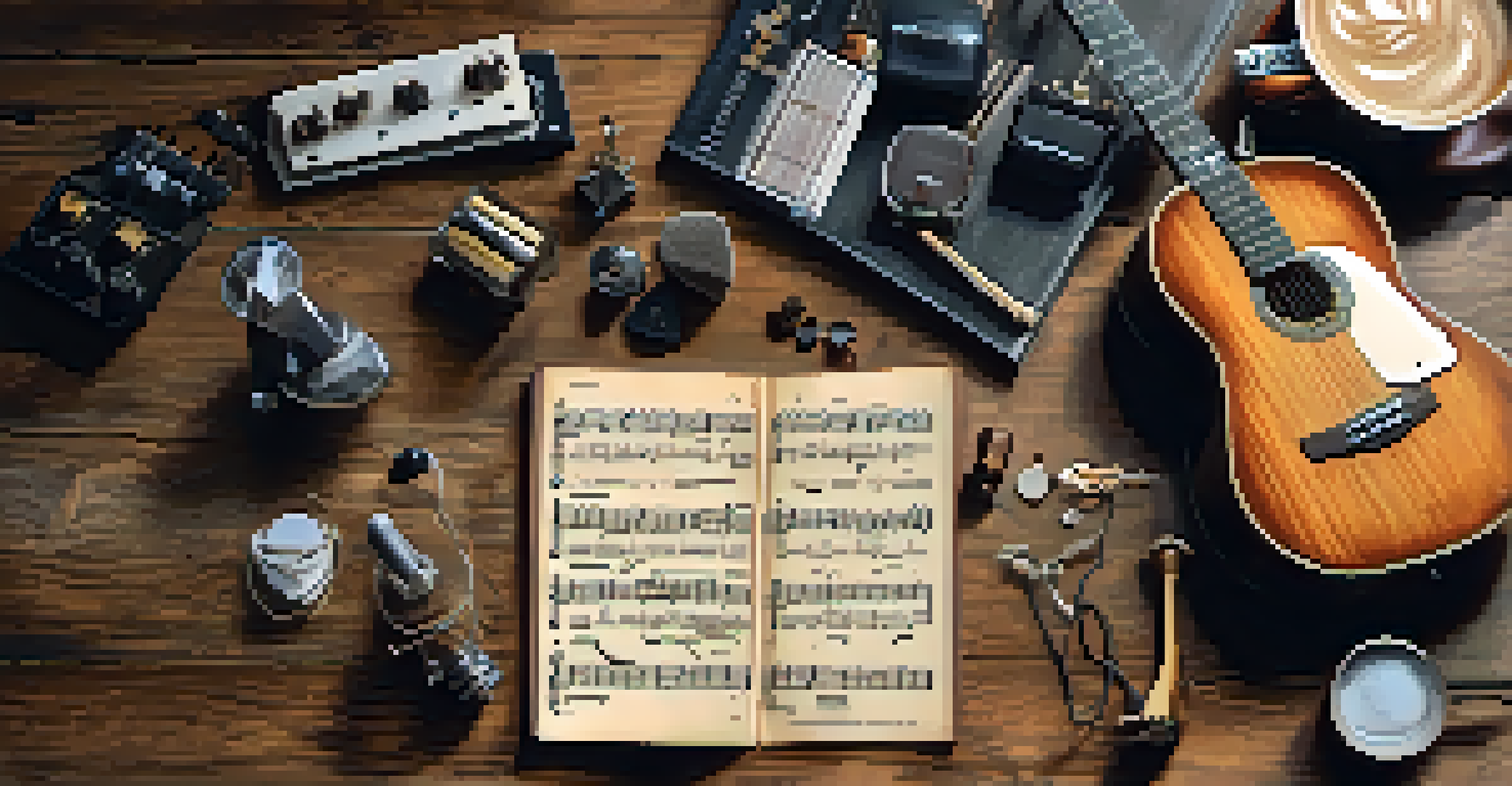Why Rhythm is Crucial for Guitarists: A Comprehensive Overview

Understanding Rhythm: The Backbone of Music
Rhythm is often described as the heartbeat of music, providing structure and flow. It's what makes songs feel alive and gives them a sense of movement. For guitarists, mastering rhythm is crucial, as it helps in playing in sync with other musicians and maintaining the groove.
Music is the shorthand of emotion.
Think of rhythm as the framework that supports melodies and harmonies. Without a solid rhythm, even the most beautiful melodies can fall flat. Just like a painter needs a canvas, musicians rely on rhythm to bring their compositions to life.
In essence, rhythm is a language of its own, communicating feelings and energy beyond words. From rock to jazz, every genre has its unique rhythmic patterns, making it vital for guitarists to understand and adapt to these nuances.
The Role of Timing in Guitar Playing
Timing is a critical aspect of rhythm that can make or break a performance. A guitarist can hit all the right notes, but if the timing is off, the music loses its impact. Practicing with a metronome can help develop a keen sense of timing and ensure consistent performance during live shows.

Consider your favorite songs—what makes them catchy? Often, it's the tight timing that allows everything to come together seamlessly. Guitarists who master timing can create dynamic solos and compelling riffs that resonate with the audience.
Rhythm is Essential for Musicians
Mastering rhythm is crucial for guitarists as it provides the structure and flow needed to create engaging music.
Moreover, good timing allows for better improvisation during jam sessions. When everyone is in sync, it opens up more creative possibilities and enhances the overall musical experience.
How Rhythm Enhances Musical Expression
Rhythm is not just about keeping time; it's also a powerful tool for expression. By varying the tempo and dynamics, guitarists can convey different emotions and intensity in their playing. For instance, a slower rhythm can create a sense of melancholy, while a faster pace can evoke excitement.
Rhythm is the pulse of music, the heartbeat that keeps it alive.
Think of iconic guitarists like Jimi Hendrix or Eric Clapton; their ability to manipulate rhythm adds depth to their performances. Each strum and pause is deliberate, allowing them to connect with listeners on a deeper level.
Ultimately, rhythm allows guitarists to tell a story through music, crafting unique experiences for their audience. This expressive capability is what sets great musicians apart from the rest.
The Connection Between Rhythm and Technique
Understanding rhythm is essential for developing proper guitar techniques. Certain techniques, like palm muting or fingerpicking, rely heavily on rhythmic precision. As guitarists practice these techniques, they must also focus on the associated rhythms to ensure their playing is cohesive.
For example, when playing a complex fingerpicking pattern, maintaining a steady rhythm can be challenging but crucial. Breaking down the pattern into smaller, manageable sections can help reinforce both the technique and the underlying rhythm.
Timing Enhances Musical Performance
Good timing in rhythm can elevate a performance, allowing guitarists to connect with their audience through dynamic solos and compelling riffs.
Incorporating rhythm exercises into your practice routine can lead to improved overall technique. This approach not only enhances playing skills but also boosts confidence when tackling more intricate musical pieces.
Learning to Play with Other Musicians
Playing with other musicians emphasizes the importance of rhythm even further. When jamming or performing in a band, a solid understanding of rhythm ensures that everyone is on the same page. This connection creates a more cohesive sound and allows for better musical collaboration.
For instance, when a drummer sets a beat, the guitarist must lock into that rhythm to create a unified sound. If one musician is slightly off, it can disrupt the entire performance, leading to a less enjoyable experience for both performers and the audience.
Additionally, playing with others exposes guitarists to different rhythmic styles and genres, broadening their musical horizons. This exposure ultimately enhances their adaptability and creativity as musicians.
Practicing Rhythm: Tips and Techniques
Practicing rhythm can be as simple as tapping your foot while playing. This simple technique helps internalize the beat and keeps you grounded in the music. Additionally, using a metronome can help you develop a steady sense of timing, gradually increasing the tempo as you become more comfortable.
Another effective method is to learn songs with varied rhythms. By analyzing and replicating different rhythmic patterns, guitarists can enhance their versatility and understanding of rhythm. This approach not only makes practicing more enjoyable but also deepens musical appreciation.
Rhythm Shapes Songwriting Creativity
Understanding rhythm influences songwriting by providing catchy hooks and clear structures that enhance the overall musical experience.
Lastly, consider joining a local jam session or music group. Playing with others provides real-time feedback and helps solidify your rhythmic skills in a collaborative environment, reinforcing the importance of rhythm in your musical journey.
The Importance of Rhythm in Songwriting
Rhythm plays a pivotal role in songwriting, influencing how a song feels and flows. A catchy rhythm can be the foundation of a hit song, often drawing listeners in before they even hear the lyrics. Guitarists who grasp the nuances of rhythm can craft compelling compositions that resonate with audiences.
For example, think about the classic pop songs that stick in your head—many of them have infectious rhythmic hooks that keep you humming along. By experimenting with different rhythms during the songwriting process, guitarists can discover unique sounds that set their music apart.

Incorporating rhythm into songwriting not only enhances creativity but also provides a clearer structure for the song. This approach allows for smoother transitions between verses, choruses, and bridges, creating a more polished final product.